#and I picked up herbs this spring so I’m surrounding them with basil and rosemary
Explore tagged Tumblr posts
Text
I have a rosebush in my garden that came eith the house, and during the first three springs and summers I lived here it never bloomed. Like Valancy Stirling’s rosebush, it shows plenty of growth, good strong green branches, but not a single bud. The last two years I cut it down almost to the dirt because all it did was get in the way.
This year it has buds.

#and also aphids#always aphids#I found a mix of chili and ginger powders in water cleared them out pretty well#and I picked up herbs this spring so I’m surrounding them with basil and rosemary#and I got marigolds for the tomatoes and chives for the peppers#it’s been so so hot and dry lately#we gotta get through this first heatwave#mine#gardening
22 notes
·
View notes
Note
what are you growing this spring?
Aw I’m so glad you’re curious enough to ask! :)
Also my boss noticed my interest in bees & honey and offered to connect me with a beekeeping friend of his this spring!! :D so my dream of becoming a beekeeper may finally come true this year
2 notes
·
View notes
Text
How to Grow a Pandemic Garden
There are all kinds of reasons that people get into gardening, most of them quite practical. Maybe you need a hobby, and like being surrounded by green things. Maybe you want to become more self-sufficient in general, and harbor homespun dreams of spending long days canning, pickling, and preserving your harvest so you can crack open a jar of summer during the cold winter months. Maybe you’re looking to pull back from the cruel capitalist churn of food production and farm worker exploitation in this country. Maybe you just want to spend less money at the grocery store, or to make it easier for yourself and your neighbors to avoid it altogether.
Or maybe the current crisis has you thinking more in the long term. The coronavirus pandemic continues to disrupt food supply chains, and unemployment numbers have soared into the stratosphere. Farmers unable to sell their crops are letting tons of produce rot in the fields (despite an urgent need from food banks), and grocery store workers fear the potentially deadly consequences of reporting to work. Without being fatalistic, it might not be a bad idea to take steps now that ensure you’ll have access to fresh produce a month or two from now.
During World Wars I and II, ordinary citizens in the U.S. (as well as a number of other countries) were encouraged to plant so-called “Victory Gardens” in order to take pressure off the straining food supply and spice up their own meager government rations. The humble backyard garden served them well then, and those of us alive now could benefit from a return to the practice—ideally without the racist, imperialist baggage that came with the second wave of U.S. victory gardens. When thousands of Japanese farmers were thrown into internment camps by the U.S. government during WWII, the food supply suffered but California agribusiness giants secretly celebrated. With their highly efficient farming methods and close-knit communities, Japanese immigrants had been a threat to the American farms’ profits, and their farms were lost alongside their freedom in an ensuing government land grab. The growth of victory gardens ties directly into that shameful episode, so for the sake of this piece, let’s just stick with “garden” for our purposes here (or “quarantine garden” if you’re really leaning into the branding).
Growing herbs on your windowsill isn’t doing it for you anymore, and those baleful houseplants peeking out at you from various corners around the apartment aren’t exactly pulling their weight, either. You’ve decided you want to take that extra leap and start your very own garden, so, let’s take stock. Say you live in an apartment in a major city, can afford to spend a few bucks on supplies, and have a little extra space to play around with. We’re not talking full-on backyard (in this economy? please) but you’ve got a solid few square feet of outdoor space that you’ve decided you want to draft into your personal war against free time. You’re ready for an upgrade.
That’s great, but there are a few things you need to consider before you dig in, pun absolutely intended.
Where Should I Plant a Garden?
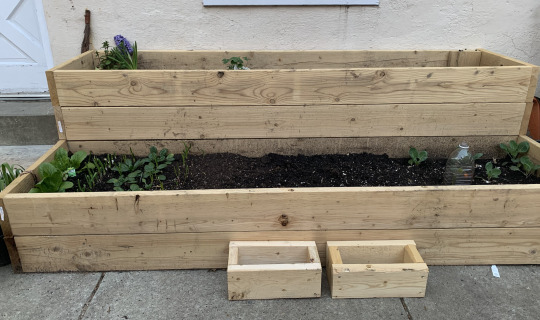
When planning out your new kitchen garden, you’ve got to keep the old real estate maxim “location, location, location” in mind. When deciding what is going to go where, you’ll want to pick out the sunniest spot possible. Vegetable plants are the opposite of intimidating goth teens in that they love the sun and crave your attention.
If you’re working with a fire escape or a stoop, you’ll probably be in good shape, but if you’re staking out a section of a shady backyard area, it’ll be a little harder to coax your crops into cooperating. You’ve also got to consider potential weather conditions. The last thing you want is for your small leafy sons to drown the next time it rains because you planted them in a weird slopey corner of the yard, or for them to fall to their deaths from the fire escape on a windy day because your dumb ass balanced them on a step. Find a nice, level spot that isn’t going to betray you the first time it rains.
How Much Sunlight Will My Garden Need?
Most plants require at least six hours of direct sunlight per day to thrive, and the more sun they get, the bigger, happier, and healthier they grow. Leafy greens like lettuce, spinach, kale, chard, and herbs like cilantro, thyme, and parsley can handle a little more shade, and root vegetables like carrots and radishes can run on only four hours if needed, but most of the beloved staples you’re going to want to grow—tomatoes, cucumbers, peppers, beans, squash, corn, basil, rosemary—are going to want to soak up that sun.
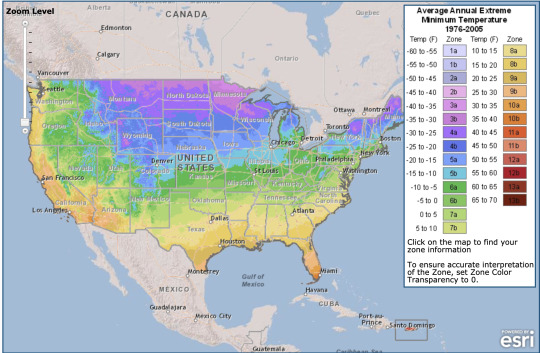
What if you don’t live somewhere sunny? You need to get familiar with your hardiness zone (which sounds like some sort of cursed Crossfit spin-off, but is actually a means by which gardeners can determine what kind of plants will thrive in their particular area during cold weather). Seed packets and live plants will note their zones on the package; if a range of zones is provided (for example, if zones 4-9, is indicated, the plant is good to go in zones 4, 5, 6, 7, 8, and 9). Also, use your common sense; while I appreciate your millennial moxie, you’re probably not going to be able to grow that avocado tree in Maine.
What Should I Grow in My Garden?
Now that you’ve got all that figured out, you need to decide what you actually want to grow in your garden. This year, we spent hours paging through seed catalogs trying to settle on the perfect heirloom varieties, but you don’t have to be that precious about it. Think about what you want to eat, what you like to cook with, and what you’d like to have on hand just in case. If you’re looking to harvest regularly or feed more than a few people, go with high-yield plants like tomatoes, cucumbers, zucchini, peas, and salad greens like lettuce and spinach.
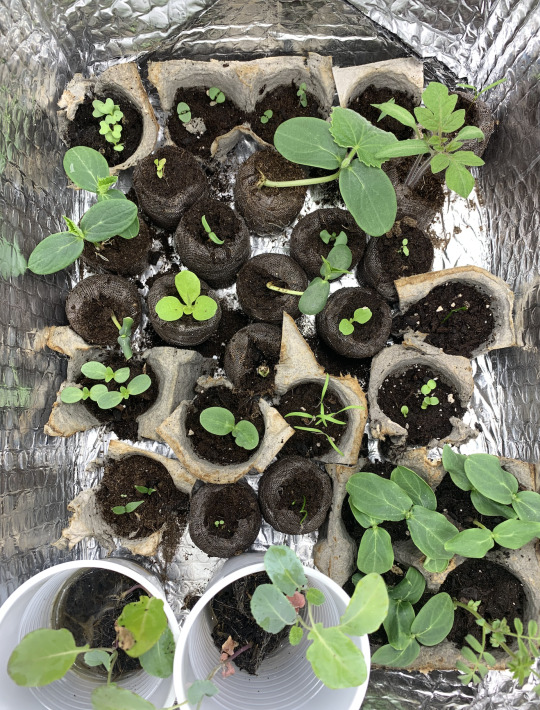
Herbs are always a good bet and play well with other plants, though you’ve got to watch out for mint—much like the U.S. itself, a mint plant will choke out the competition and colonize every inch of space around it if left to its own devices. You can achieve a nice balance of function and form by growing pretty flowering herbs like lavender, chamomile, yarrow, and borage. These will have the added benefit of attracting bees and butterflies, which is as adorable as it is necessary to keep your plants well-pollinated. (Tip: If you’re going to be using containers, look for varieties labeled “compact,” “space saver,” or “bush;” these mini-versions of popular garden staples are bred to take up less space than usual, leaving you more room to maneuver).
Where Can I Get Plants For My Garden?
Do you want to start from scratch and buy seeds, or would you rather pick up an armload of baby plants from your local garden center? Are you going to throw in a few wild cards, like those spring onions you’ve been idly regrowing on the countertop?
If you’ve never tried to grow anything before (or have, and found yourself to be the unhappy possessor of a black thumb), it might be a good idea to start off with a few store-bought (or gifted) plants to get your confidence up before you tackle anything more demanding. You can try out some of those vegetable regrowing hacks that are always floating around Instagram, but the only one that’s ever reliably worked for me is the spring onion trick (where you simply place the white bulb roots-down in a cup of water, and watch as they regenerate into full-grown onions again).
How Do I Start Seeds Indoors?
In my own personal experience, starting seeds inside is a pain in the ass, but depending on what I’m trying to grow, it’s often a necessary evil. Some plants are tricky, and can’t be directly sown (i.e. planted directly in the soil outside). Instead, they need to be “started” indoors and kept inside until they’re strong enough to withstand the elements.
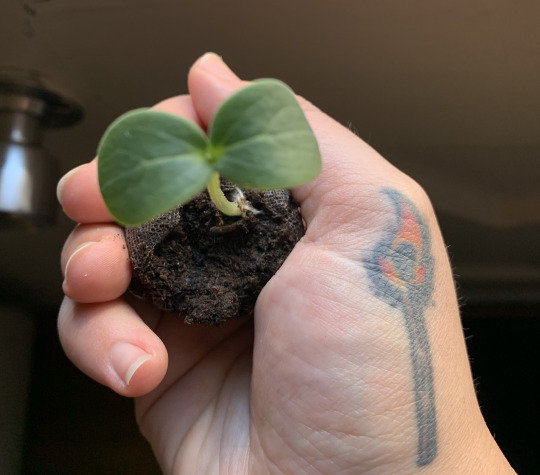
There are a number of ways to do this and endless tutorials online, but I’ve had the best luck so far with the following method. Take a cardboard egg carton, fill the little cups with potting soil, and plant each cup with three or four seeds. Keep the soil damp and stow the carton in a warm, dark place until you see sprouts, then move the babies under a grow light or under a sunny window, and let them get their strength up. Once they’ve had a week or so to grow, start moving them outside for a few hours each day to “harden” them, or get them used to the changes in temperature. Gradually increase the time spent outside for the next seven to ten days, until you’re ready to transplant them. You can then cut the egg cartons apart and plant the individual cups directly in the soil, and welcome them into their new home by giving them plenty of water. (Your mileage here may vary; seeds can be finicky little dicks, and I’ve already had to re-start like 50 of them this year. Don’t give up!).
What Are Raised Beds, and Does My Garden Need Them?
Once they’re all grown up and ready to move out, are your plants going to live in pots and containers, or are you dreaming bigger? If you’ve only got a few feet available, a couple of big, deep containers will be your best bet here. As a bonus, containers are especially good for vertical gardening. Adding a trellis, wire cage, or other support system gives vine-y plants like tomatoes, cucumbers, squash, sweet potatoes, and beans room to climb, which is handy when space is at a premium (and if you’re feeling really ambitious, you can try to train your vines to wrap around your balcony or fire escape).
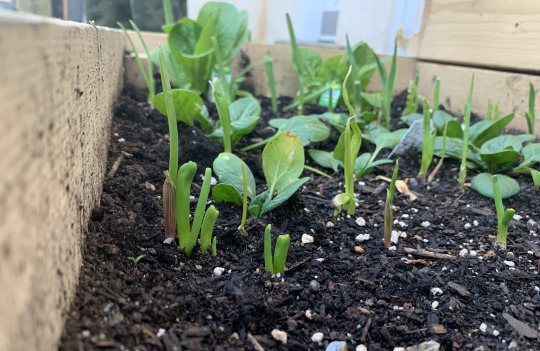
My other half (who has a background in agriculture and is fact-checking this over my shoulder as I write it) got a little fancy with our garden this year and built some raised beds. A raised bed is basically a flat box that sits on top of the soil (or concrete), and they’re great for beginner gardeners because you can control important variables like soil quality, drainage, pests, and weeds. They don’t need to be expensive, and are pretty easy to build; there are millions of tutorials on YouTube, and you can make them out of pallets or cheap lumber. (You can also buy ready-made ones, but those are needlessly expensive and I promise you can just do it yourself for a fraction of the cost). Ours are 8’ x 4’ due to the shape of our weird little front yard, but you can go much bigger or smaller depending on your situation. If you have the space for them, raised beds are a great option for city gardens, or in places where the soil is contaminated or otherwise inhospitable.
What Kind of Soil Do I Need For My Garden?
The next step is choosing the right soil for what you’re looking to grow. Different plants thrive in different kinds of soil, but basically any soil you’re going to encounter can benefit from adding compost to it, so throw a few bags of that into your shopping card before you leave Home Depot (or start making your own). Some vegetables like carrots, cucumbers, garlic, tomatoes, onions, cauliflower, and sweet peppers also prefer slightly acidic soil (so do most berries!); luckily, there are a number of ways to up the dose of acid in your soil, some store-bought and some DIY. I sometimes add used tea leaves or coffee grounds to the soil around these plants, and you can also mix two tablespoons of vinegar into a gallon of water and use that for an easy fix. You can also just buy soil with a higher acidity level. (“Just buy some” is usually an option for most things when it comes to gardening, but we try to keep things as DIY and organic as possible in our garden, because this shit can get expensive).
So now you’ve got your space scoped out, you’ve got your plant babies at the ready, you’ve got your containers set up, you’ve got a bunch of dirt locked and loaded, and you’re feeling good about your setup. It’s finally time for the fun part—planting! Make sure to make a nice deep pocket in the soil to place the plant down into, fully cover the roots, and to water them thoroughly once they’re settled. Good job! You have a garden now.
How Do I Keep My Garden Alive?
It’s always a good idea to read up on the types of vegetables you’ve planted beforehand so you understand how much water each kind will need each day after that (again, don’t drown your babies!). Familiarize yourself with each plant’s needs, and settle in for the final, hopefully most fruitful chapter of your garden journey: doing your best to keep the damn things alive. It will require care, effort, and somewhat constant vigilance, but it’ll be worth it. If you spot any stray weeds, remove them; if you see a suspicious bug or odd colorations on a plant’s leaves, Google them and take care of it. I can guarantee that for any garden problem you encounter, someone else has already written a how-to guide on how to fix it.
Don’t pick things before they’re ripe, or let veggies rot on the vine. Be kind to your plants, even the ones that get droopy or don’t produce as well; they’re doing their best. Most importantly, once you start harvesting your bounty, share the abundance with your friends and neighbors (from a safe distance). Remember, nothing tastes as sweet as mutual aid.
How to Grow a Pandemic Garden syndicated from https://triviaqaweb.wordpress.com/feed/
0 notes
Text
Cool Landscaping design ideas backyard
Advantages of Long Leaf Pine Needles in your landscaping: It provides the best level of level of acidity for your plants to absorb maximum soil nutrients It does not drift and remove and breaks down more gradually, so it doesn't require to be reapplied as frequently as other mulches It is much easier to handle and lighter per cubic foot than other mulches: one large bale can cover as much area as 30 cubic feet of a lot of mulches the cost per square foot is competitive with other mulches It breathes better, doesn't compact, and enables better water infiltration It is simple to apply: just unroll the bales and scatter by hand It doesn't draw in termites It adds natural product and nutrients to soil and lowers weeds The consistent color and great texture of pine straw brings out the color, contrast, and texture of your landscape You can use it for erosion control where grass will not grow to hold soil, even on hillsides and paths Frequently Asked Questions
What Should A Grow In My First Garden? So I Recently Bought My First House And Would Love To Have A Vegetable Garden But I'M Not Sure Where To Start. I Do Know A Little Something About Growing Plants But I'M Not An Expert On The Subject By Any Means. I Figured I Would Start Small. A Few Of The Things A Would Like To Try Are Herbs (Basil, Rosemary, Sage, Chives, Thyme) Carrots, Squash, Beets, And Maybe Potatoes. So I Would Like To Know If These Things Would Be Easy Enough For A First-Timer To Grow? Any Suggestions On Other Types Of Vegetables Or Herbs? Should I Start By Seed Or Buy Smaller Plants? Also, I Live In Maine So The Growing Season Is A Little Ways Off But I Know Some Things Just Won'T Grow Well Here. I Should Also Add That I Have A Spot That I Plan On Using That Gets A Lot Of Light For Most Of The Day But For The Most Part My House Is Surrounded By Trees So I Have Shaded Areas Too That I Could Use For Shade Loving Plants. Oh And I Would Love To Grow Everything Naturally/Organically So If Anyone Has Any Tips On Books Or Websites On Organic Farming That Would Be Great Too! Thanks!
If you want to go organic, mushroom compost makes your plants thrive. For a first garden, do yourself a huge favor & just pick up baby plants from a farmer's market. If you have a water source/irrigation system they'll do great, but if not they will dry up. A drip hose may be easiest for you (soaker hose) if no sprinkler system. The soil has to be loose, to provide drainage for the roots. As you have mostly shade, you may have to split the garden into 2 or 3 small areas that do get sun- that is key to growing most vegetables. If not, you'll get very healthy leaves, but nothing to eat! One easy trick is to build up an area with logs or railroad ties in an 8'x8' square, or however big you want it. Fill that with good soil, which will contain the nutrients you put in it, instead of having it wash into other areas. Have you looked into composting? Plants need lots of good nutrition in order to provide it. You should also mulch with either bark, newspaper strips, pine straw or composted leaves to keep weeds away. Are you against using a squirts of diluted Dawn when you start seeing bugs? Of course, you have to wash the veggies off, but hey- at least they'll be clean~ ~m~
How To Grow Peachtree From Seed ? Does Any One Know How To Grow A Peachtree From A Seed I Would Like To Try. Then How Long Tell It Produces Peaches
I've always wanted to try that myself, for example, I'd get to the core of an apple and be like "I wonder if I...." So I looked it up. If I remember correctly growing any of the fruit trees from scratch is rather difficult and it may take a year or two before you see any fruit, but here's what I could scrounge up about peaches: "Starting peach trees from seeds is not recommended because the seed will not exactly produce the same variety as the tree the pit came from. However, if you wish to try, they will either need to be stratified artificially or by Mother Nature. Place the seeds in moist paper towels in January and then in a zip-lock plastic bag and place in the refrigerator until April. At this time they will be ready to plant in a pot or in the ground. Or place the seeds in a pot of loose potting soil in early winter and allow Mother Nature to do the job for you. You will need to keep the pots watered during the winter months if it doesn't rain occasionally. The seeds should sprout naturally in the spring once the weather conditions become favorable." which I got from: http://plantanswers.tamu.edu/fruit/peach... and also I found this: "Have you ever wanted to grow a peach tree from a peach pit? It can be done. Peaches from seed can result in trees that bear decent fruit, although they may not look or taste just like the peach from the pit came. Most commercial peach varieties are budded onto specific varieties of rootstock. In any case, peach pits can be planted in fall in a garden area, just as if you were planting any other seed. Plant them about 4 inches deep and apart in a row. Cover with an inch of straw, pine needles or similar mulch and then water. Throughout winter, water the row when conditions have been dry and warm with no snow cover. Many of the pits will germinate the following spring. You can transplant them to pots for growing to a larger size, or move them directly to their new location. Avoid planting peaches on southern exposures, as the extra heat would cause them to bloom even earlier in spring, ensuring that late frosts would prevent fruit development. Eastern or northern exposures are best, but it will be several years to fruiting size from a seedling peach. Note that the late frosts our area receives will typically mean that peaches develop only one or two years out of five." Which I got from: http://coopext.colostate.edu/4dmg/VegFru... Here's a nifty PDF I also found: http://hortweb.cas.psu.edu/extension/tre... After skimming through these, you might be better off buying baby trees and planting them. You still might have to wait until you get your first fruits but at least you know the fruit you will get will be either the kind you like, or tasty in general. And you'll already have a head start on it growing, and you don't have to worry about any seeds not germinating. Hope this helps

0 notes